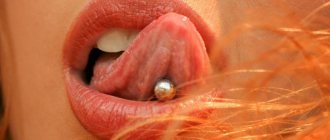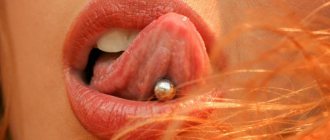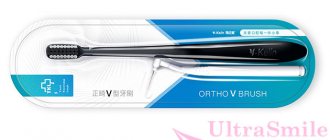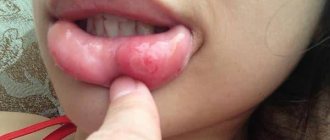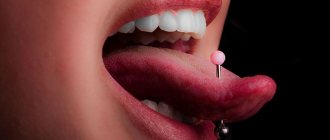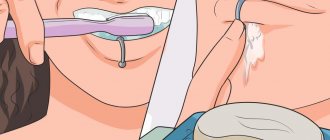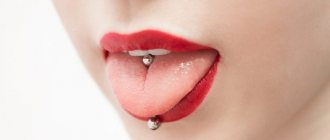Tongue piercing is one of the most popular types of piercings. Lots of young people get tongue piercings.
What are the benefits of tongue piercing?
- Unusual, erotic, shocking, very fashionable.
- Heals quickly.
- There is no trace of the piercing left, the channel is healed within a day.
Tools for tongue piercing: tongue holder or oval window clamp, catheter needle No. 16, No. 18.
Earrings: for the first puncture and healing, it is better to use a polyethylene barbell earring, 18-19 mm long. This is a length with a margin for tongue swelling. After 3-6 weeks, when the canal is fully formed, the barbell can be changed to another (14-16 mm).
Attention! If you have gold crowns in your mouth, then you cannot wear steel piercing jewelry for a long time. A “galvanic couple” occurs, and constant irritation of the mucous membranes is possible. In this case, you need to use plastic or titanium tongue decorations.
Treatment before piercing the tongue: the mouth should be rinsed with a 3% (diluted 1:1 with water) hydrogen peroxide solution. Rinse - 5 minutes. A banana earring with an unscrewed ball should be immersed in an antiseptic solution for 15-20 minutes (95% alcohol, disinfectant solutions).
Place of tongue piercing: the main landmarks are the central line and the frenulum of the tongue. The injection point is located under the tongue in the midline, without affecting the frenulum.
Types of tongue piercing
There are four types of tongue piercing:
► Vertical - from the frenulum to the palate. Classic and most common puncture.
► Horizontal - the puncture is located on the tip of the tongue, from ear to ear (wide)
► Superficial - the puncture is made across the tongue
► Tongue frenulum piercing – piercing under the tongue
What decorations can be used
The most popular options for tongue decorations include:
- Classic barbells. This is a straight cylindrical rod with decoration on the tips.
- Curved rods. Resembles the shape of a banana.
- Labrets. These are rods on which there is a disk on one side and a round clamp on the other.
- Rings and earrings. Typically used for insertion into the edges and tip of the tongue.
An important criterion is the material of the decoration. It is better to choose hypoallergenic metals such as gold and silver. A fairly universal and inexpensive solution is jewelry made of nickel-plated steel and brass. Another good alternative is a titanium barbell.
You should avoid tongue bars and earrings made of plastic and wood. Despite the very low price, they can contribute to the development of infectious complications and allergic reactions.
Choosing jewelry for piercing
Jewelry for tongue piercing must be made of high-quality material - titanium . Medical steel, gold, silver and other metals contain foreign alloys, which, when in the human body, begin to oxidize, and in the oral cavity this process is much faster, so the consequences after tongue piercing with such jewelry will be very unpleasant. For primary healing, 1.6x22 rods are used (sometimes longer, based on individual measurements of the tongue); a shorter rod can be replaced 2-3 weeks after the puncture. For those who really want a tongue piercing, but have not yet decided, there is a tongue piercing - such jewelry is held on by suction cups or magnets.
What will happen to the gums
In people with tongue or lip piercings, a factor is constantly present in the mouth, leading to an increased accumulation of plaque and the dominance of bacteria - and this, in turn, provokes inflammatory processes in the mucous membranes and can cause stomatitis, gingivitis and periodontitis. It is also important to emphasize that the habit of “playing” with fashionable jewelry and moving it back and forth in the mouth can cause not only injuries to the teeth and their roots (especially in the lower jaw), but also severely rub the tissue, cause damage to the mucous membrane, lead to bleeding, the formation of ulcers, erosions and aphthae.
On a note ! According to research, wearing a piercing in the mouth is one of the factors that can lead to gum recession, exposure of tooth roots, as well as displacement, loosening and premature loss of the latter.
Puncture procedure
First of all, the master helps you choose jewelry. For initial healing, a 1.6x22 bar is placed in a classic tongue piercing; this is a standard size, which, in case of swelling after the piercing, will prevent the jewelry from digging into the tongue. Wraps are selected for the bar depending on the client’s preferences. Next, the master gives the client to rinse his mouth with octenisept and makes markings, looking at the anatomy of the tongue. After this, sterilized instruments are taken out, the tongue is held with a special round clamp and a puncture is made with a piercing needle, with the help of a taper the jewelry is smoothly inserted and the screw is screwed on. After the piercing, your tongue will hurt and swell, but you shouldn’t be afraid of this; the pain will go away quickly if you follow all the recommendations that the master will give you.
The dangers of piercings for gums
Not only lip piercing (as is commonly believed) negatively affects the health of the gums, but also any other type. If metal earrings cause damage to teeth in the form of constant impacts, then friction poses a greater danger to gums. Statistics say that 70% of patients with oral piercings experience severe damage to their gum tissue. In addition to gums, metal piercings can also damage crowns, which can later lead to tooth loss.
If you have already suffered from oral piercing, you may experience the following symptoms:
- Swollen tongue. In extreme cases, it can block the airways, which will significantly complicate breathing;
- Increased fragility of teeth, their splitting, cracks;
- Excessive salivation;
- Partial loss of taste;
- Decreased gum level (loss);
- Uncontrolled sudden bleeding;
Tongue piercing care
In order for the piercing to heal well, you need to know how to care for your tongue piercing. Caring for a tongue piercing includes constant treatment of the oral cavity - Lakalut, Asepta or President rinses ; you need to rinse your mouth 4-5 times a day and after each meal and drink. Swelling after tongue piercing lasts at least 4-5 days, so during this time you will have to refrain from active conversations, hard, spicy and salty foods . If you notice that plaque has appeared after your tongue piercing, you should not try to remove it, as you will injure the piercing. After 2-3 weeks, you can change the barbell to a shorter one (downsize).
How bad is it for teeth?
If you get a tongue piercing, will it damage your teeth? Yes, premature destruction of enamel and dentin is more than real, because the earring located in the mouth constantly has a mechanical effect on the surrounding tissues. Owners of fashion accessories often have the following problems:
- the appearance of cracks and chips on the enamel: the front units of the row suffer the most, because they bear the main “blow”,
- increased sensitivity and abrasion of hard tissues,
- the risk of developing caries and other dental pathologies increases.
Expert opinion
Elina Ruslanovna Dzagurova
Specializations: Dentist-therapist
Experience: 11+
“If there is a piercing in the mouth, then various restorations carried out in the smile area in order to improve aesthetics serve less. Especially with ceramic, composite or plastic coating. Decoration damages their surface, leaving scratches and cracks as easily as on the surface of natural teeth.”
How is a smiley piercing done, does it hurt?
The procedure begins with choosing a frenulum decoration - the smile piercing is one of the few types of piercings that can accommodate almost any type of jewelry . Next, the master begins to prepare the instruments and sterilize them. After preparing the instruments and the workplace, the master treats the oral cavity with a special antiseptic (most often it is octenisept); markings for this puncture are not required. The master lifts the lip slightly and pierces it at an angle of 90 degrees to the frenulum (a clamp is most often not used to avoid deformation of the frenulum). The puncture takes literally a couple of seconds , then the master carefully inserts the jewelry without removing the needle. The procedure is very quick and virtually painless, but it all depends on your pain threshold. One thing we can say for sure, piercing the frenulum is quick, you won’t even have time to realize everything. That's it, the procedure is over, now you are the owner of a rather unusual, but aesthetic puncture!
What is a tongue piercing?
Piercing is a kind of surgical intervention that does not last long. It involves punching the tip of the tongue and then inserting a special barbell earring, staple or stud into it, which are made of durable medical steel or titanium. This earring goes right through the fabric, so it can be seen both above and below.
stylish decoration
suitable for girls and boys
How to pierce your tongue at home
You need to choose a well-lit room so that there is a place to lay out the instrument. Use only disinfected clamp, needle and earring. Wash your hands with soap and wipe with a disinfectant solution. Perform actions wearing disposable sterile gloves:
- Treat your mouth with an antiseptic.
- Choose a puncture site in the middle, closer to the tip of the tongue, there are no large blood vessels there.
- Pinch the tongue with tongs, then use a special needle to pierce it strictly perpendicular to the surface.
- Use a catheter to insert the earring.
- Medicines for high blood pressure - a list of effective medicines
- Miramistin for thrush
- Stye on the upper eyelid - how to treat it in a child
Possible consequences
Due to improper care or work of an unqualified specialist, the following consequences are likely to occur:
- the risk of contracting HIV, hepatitis C and other dangerous infections;
- allergic reaction to the materials used;
- heavy bleeding;
- nerve damage and loss of organ sensitivity;
- development of chronic inflammatory gum diseases.
piercing can spread HIV or cause bleeding
Contraindications
Piercing is quite popular these days. But tongue piercing is not available to everyone. Before you decide to have surgery and go to the specialist, you need to study the list of contraindications:
- allergy to antibiotics;
- pregnancy period (the risk of infection poses a serious threat to the expectant mother and baby);
- allergy to metals;
- diseases of the nervous system;
- poor blood clotting;
- oral diseases;
- epilepsy;
- some autoimmune diseases (diabetes mellitus, hemophilia).
Tongue piercing is a modern procedure that helps a person stand out among the “crowd.” But before you decide to have a puncture, you need to evaluate all the disadvantages, consequences and dangers of a difficult operation.
Sources used:
- Harden, Blaine. Coming to Grips With the Enduring Appeal of Body Piercing, The New York Times
- A. Stirn (2003): Body piercing: medical consequences and psychological motivations., The Lancet
- Wikipedia material
Recovery period
The most painful and unpleasant sensations occur during the recovery period. Until the wound surface heals, a person must observe strict restrictions.
On the first day after surgery, the surface of the tongue is very sore and swollen. These changes are normal, pain is the result of soft tissue trauma, and swelling is the cause of damage to lymph flows and blood vessels. The swelling may last for several days.
The wound heals within 2-3 weeks. Complete healing of the wound surface occurs 3-4 months after surgery.
During the first weeks after surgery, you should be careful about your diet. It is important to exclude all spicy, smoked, salty foods from the menu. Dishes should not be hot. It is optimal to eat liquid, fresh, warm food.
Caring for a pierced tongue
The basis of tongue piercing care is the treatment of soft tissues. Every day, twice a day, the wound needs to be treated with antiseptic solutions (Chlorhexidine, a solution of baking soda or potassium permanganate).
For the first 2 weeks after surgery, you need to rinse your mouth after eating. The first days, rinsing is carried out with antiseptic solutions (Chlorhexidine). In the future, you can rinse your mouth with decoctions of medicinal herbs (chamomile, sage, calendula).
Barbell care
For 2 weeks after the tongue piercing, you need to clean the barbell daily with a toothbrush. After this time, it is necessary to regularly remove the “decoration”, thoroughly clean it of surface contaminants and disinfect it in a Chlorhexidine solution.
Pros and cons of tongue piercing
Piercing always attracts attention, making the wearer stylish and arousing the interest of others. By agreeing to this complex procedure, a person feels special and shows individuality. There are several reasons to get a piercing:
- A person liberates himself, tries something new, partly shocks those around him, challenging the routine and ordinariness of gray everyday life.
- This type of piercing is easily hidden and is not noticeable. Without removing the jewelry, you can show it or hide it.
- During kissing and oral sex, the earring additionally stimulates the partner’s sensations and adds exoticism to the relationship.
- During healing, you have to follow a diet for a long time, so you can lose weight by losing your usual diet, which will please those who want to lose excess weight.
If you want to impress others with a tongue piercing, you will have to put up with the following inconveniences:
- The first thing that awaits those wishing to get a tongue piercing is the painfulness of the procedure.
- Healing is long and uncomfortable. It will take several months for complete recovery.
- The operation is expensive. It is better to do it in a clinic with an experienced specialist, rather than at home. Saving in this case is not worth it.
- When contacting a bad surgeon, there is a high probability of infection due to unsterile instruments. We are talking not only about infection of the wound, but also about more serious diseases: hepatitis and herpes.
- You will have to put up with dental damage. This is a consequence of the fact that the earring is often chewed. When chewing, there is a high probability of touching the decoration.
- The pleasure of showing off an earring increases the risk of gum disease. Having a foreign object in the mouth, especially with insufficient care, boys and girls get an increase in the number of bacteria and infection of the oral cavity.

